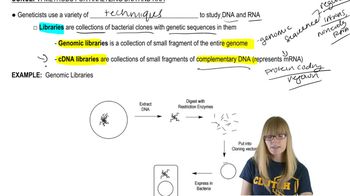A victim of murder is found to have scrapings containing skin cells under several of her fingernails. Genetic analysis confirms that the DNA isolated from these cells came from the same individual and does not match the DNA of the victim. The results shown below are for six CODIS STR markers from the crime scene DNA (from under the victim's fingernails and presumed to be the murderer's), and from three suspects (A, B, and C) who have been detained for questioning about the murder. Is there a failure to exclude any of the suspects? Explain.
Table of contents
- 1. Introduction to Genetics51m
- 2. Mendel's Laws of Inheritance3h 37m
- 3. Extensions to Mendelian Inheritance2h 41m
- 4. Genetic Mapping and Linkage2h 28m
- 5. Genetics of Bacteria and Viruses1h 21m
- 6. Chromosomal Variation1h 48m
- 7. DNA and Chromosome Structure56m
- 8. DNA Replication1h 10m
- 9. Mitosis and Meiosis1h 34m
- 10. Transcription1h 0m
- 11. Translation58m
- 12. Gene Regulation in Prokaryotes1h 19m
- 13. Gene Regulation in Eukaryotes44m
- 14. Genetic Control of Development44m
- 15. Genomes and Genomics1h 50m
- 16. Transposable Elements47m
- 17. Mutation, Repair, and Recombination1h 6m
- 18. Molecular Genetic Tools19m
- 19. Cancer Genetics29m
- 20. Quantitative Genetics1h 26m
- 21. Population Genetics50m
- 22. Evolutionary Genetics29m
18. Molecular Genetic Tools
Methods for Analyzing DNA
Problem E.7a
Textbook Question
The results shown are from a DNA test for four genes used in a paternity identification case. DNA for the mother (M) and her child (C) are shown along with DNA from two possible fathers, F1 and F2. In the 'C' column, label the DNA bands contributed by the mother with 'M' and the DNA bands contributed by the father with 'F.'
 Verified step by step guidance
Verified step by step guidance1
Step 1: Understand that a child inherits one allele (DNA band) from the mother and one allele from the father for each gene. Therefore, for each gene, the child's DNA bands should be a combination of one band from the mother and one band from the father.
Step 2: For each gene, compare the child's DNA bands with the mother's bands. Identify which band(s) in the child match the mother's bands. Label these matching bands in the child's column as 'M' to indicate maternal contribution.
Step 3: After labeling the maternal bands, the remaining band(s) in the child's DNA for each gene must have come from the father. Label these remaining bands as 'F' to indicate paternal contribution.
Step 4: Repeat this process for all four genes, ensuring that for each gene, one band is labeled 'M' and the other 'F' in the child's DNA column.
Step 5: Use the labeled paternal bands in the child's DNA to compare with the DNA bands of the two possible fathers (F1 and F2) to help identify which father contributed those bands.
 Verified video answer for a similar problem:
Verified video answer for a similar problem:This video solution was recommended by our tutors as helpful for the problem above
Video duration:
4mPlay a video:
Was this helpful?
Key Concepts
Here are the essential concepts you must grasp in order to answer the question correctly.
Mendelian Inheritance and Allele Contribution
Each individual inherits one allele of a gene from each parent. In paternity testing, the child's DNA bands must match one allele from the mother and one from the father. Identifying which bands come from the mother helps isolate the paternal contribution.
Recommended video:
Guided course

New Alleles and Migration
DNA Banding Patterns in Gel Electrophoresis
DNA fragments are separated by size using gel electrophoresis, producing distinct bands. Comparing band patterns between individuals reveals shared alleles. Bands present in the child but absent in the mother indicate paternal origin.
Recommended video:
Guided course

Methods for Analyzing DNA and RNA
Paternity Testing Using Genetic Markers
Paternity tests analyze multiple genetic loci to determine biological relationships. Matching the child's paternal bands with those of potential fathers helps identify the true father. Consistency across several genes strengthens the accuracy of the test.
Recommended video:
Guided course

Mapping with Markers

 7:40m
7:40mWatch next
Master Methods for Analyzing DNA and RNA with a bite sized video explanation from Kylia
Start learningRelated Videos
Related Practice
Textbook Question
430
views
